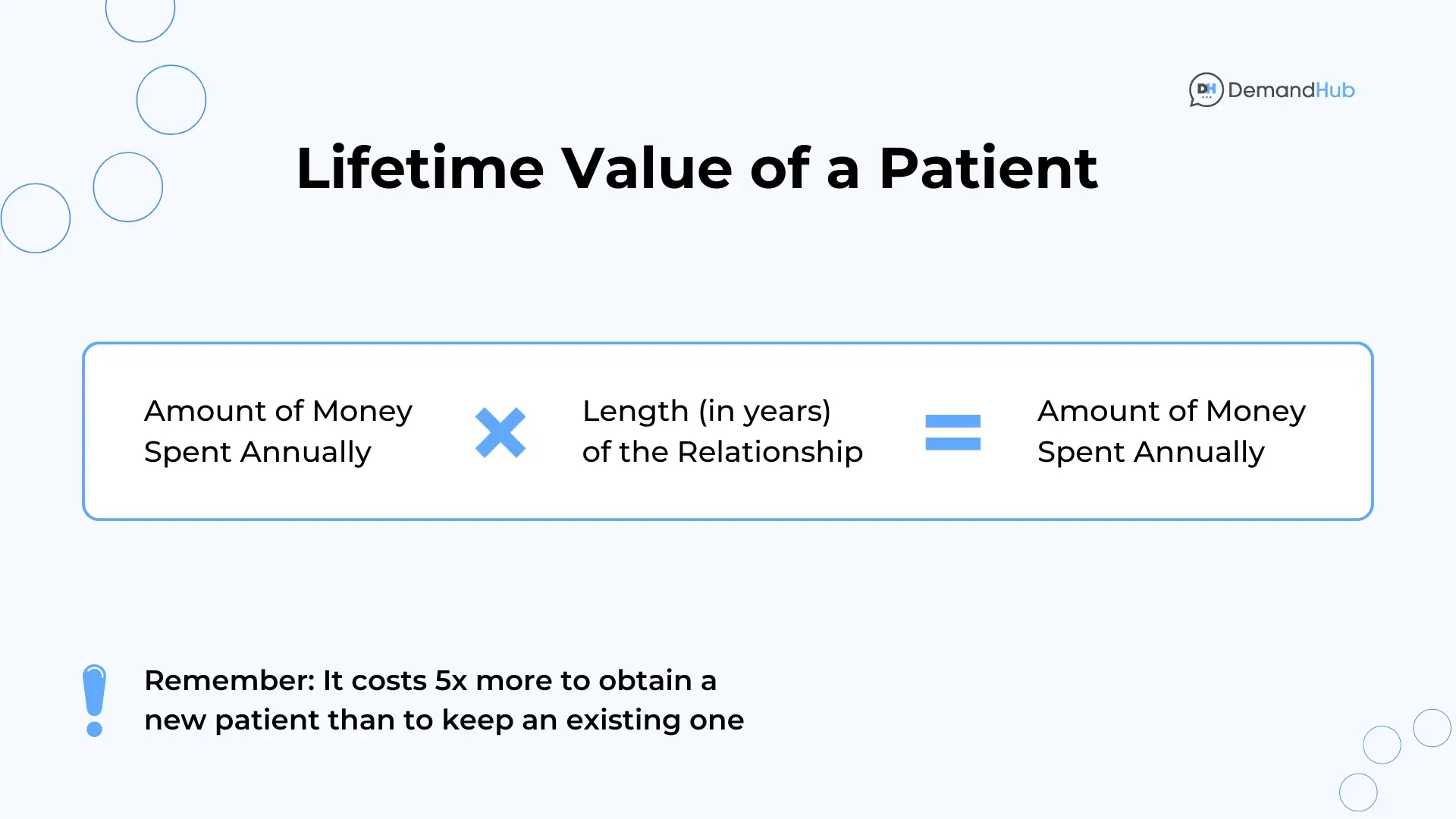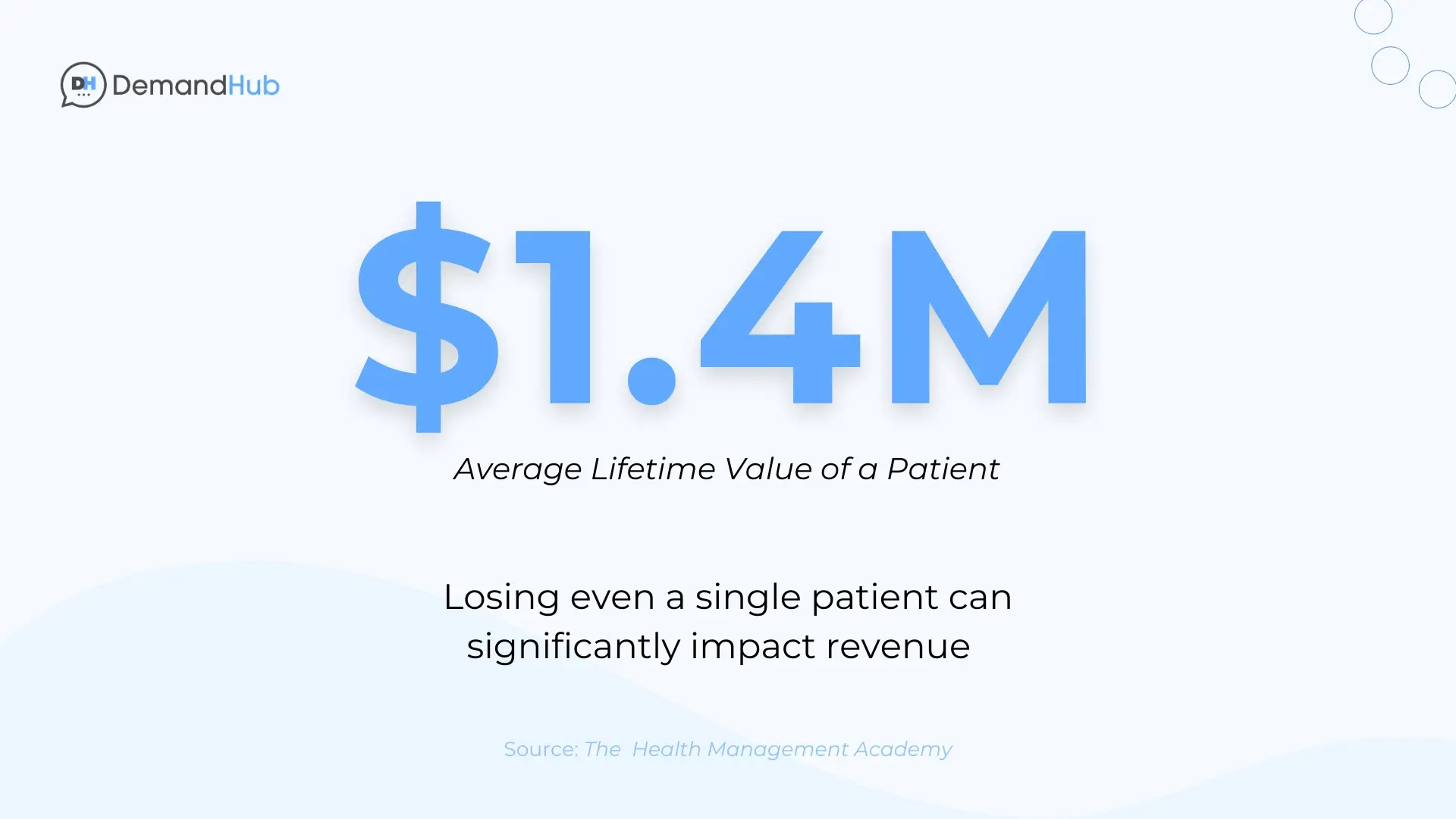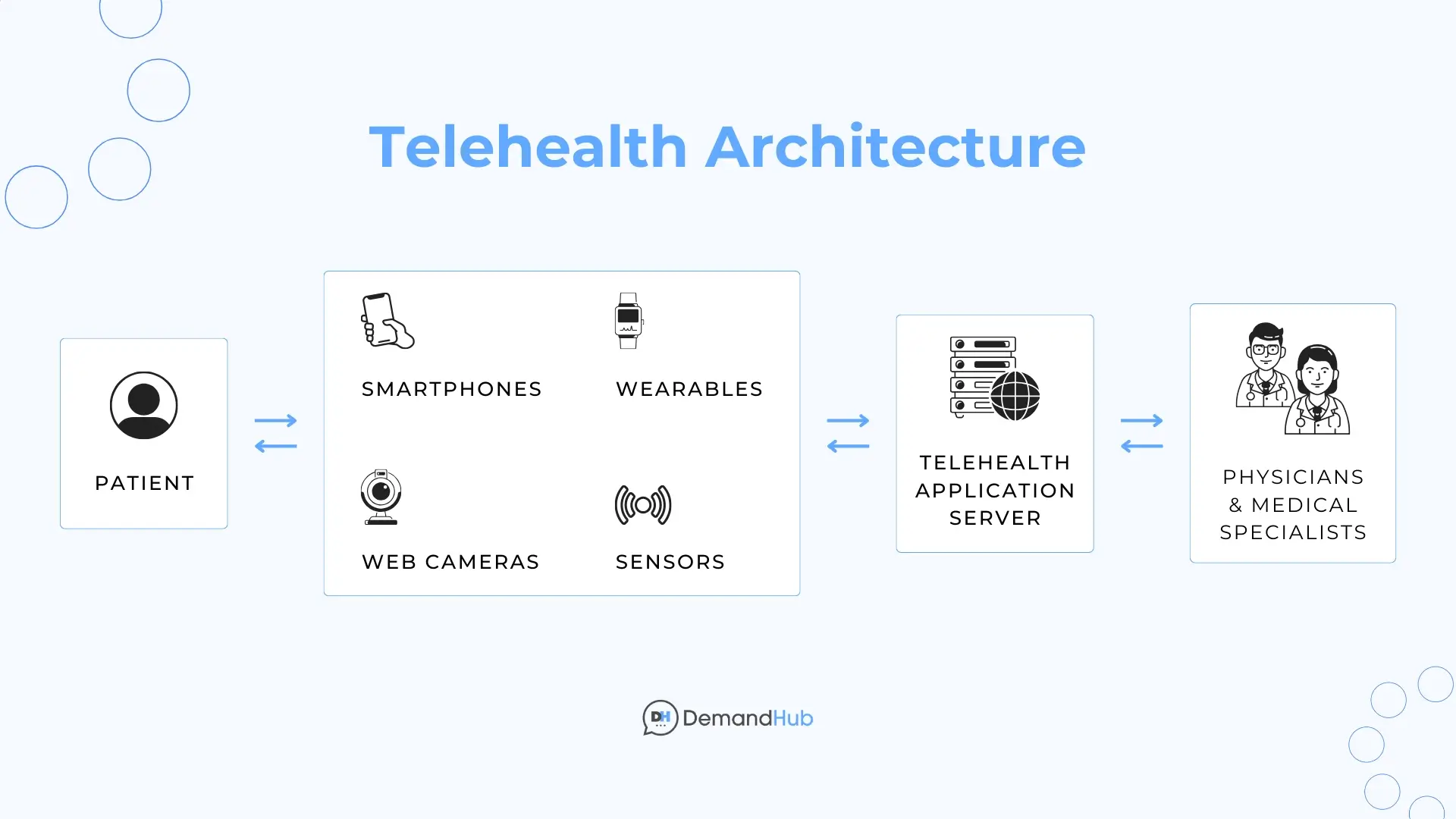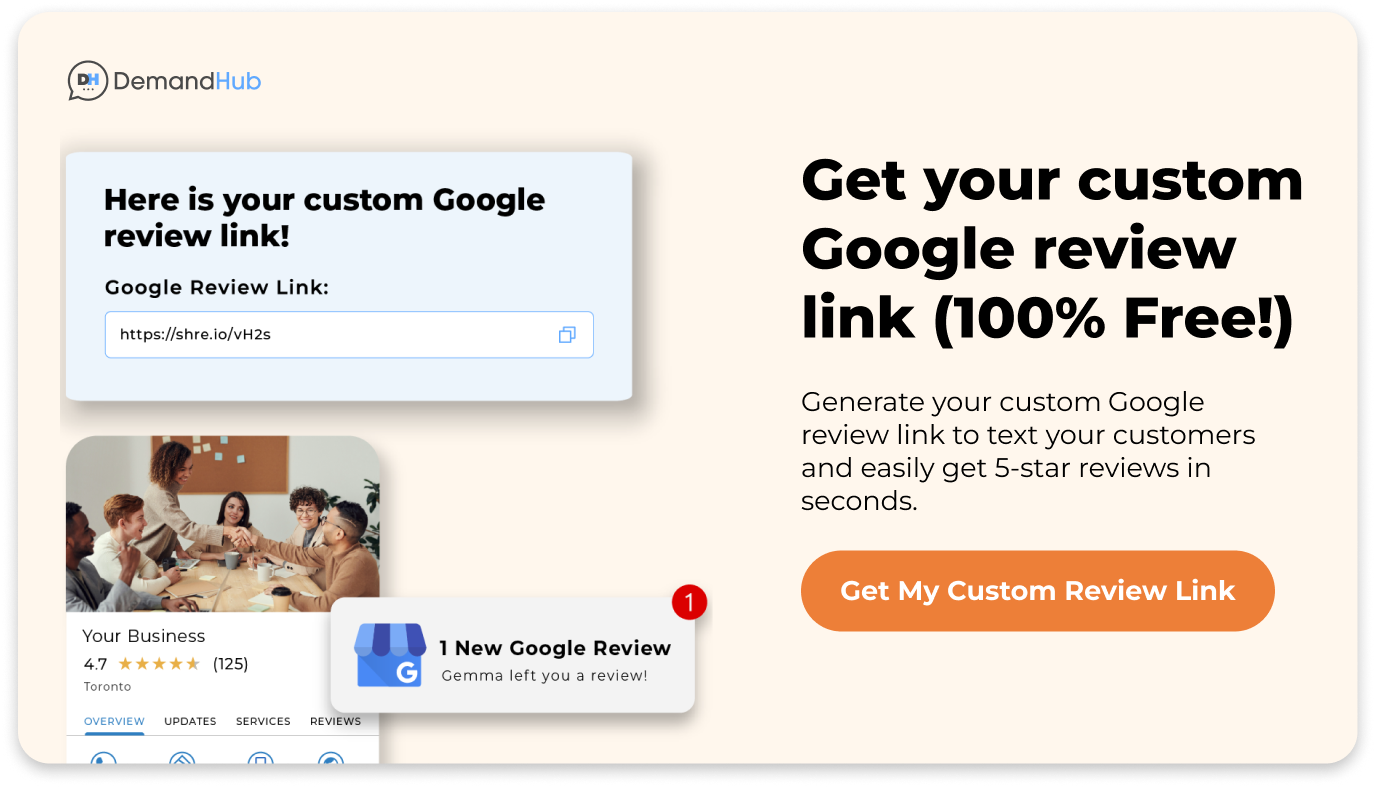9 Proven Patient Retention Strategies That Attract Patients Like Magnets

Did you know that retaining an existing patient can cost up to five times less than acquiring a new one?
Patient retention is pivotal to your clinic’s reputation and bottom line. The importance of keeping patients loyal and satisfied cannot be overstated. But how do we achieve this when patients have countless options at their fingertips?
The answer lies in data-driven patient retention strategies.
Harnessing the power of data-driven patient engagement techniques can unlock insights, tailor experiences, and, ultimately, keep patients coming back.
Table of Contents- What is Patient Retention?
- Why is Patient Retention Important?
- Understanding Patient Turnover
- Why Patients Leave?
- The Financial and Operational Impact of Patient Turnover
- The Power of Data in Healthcare
- How is Data Analytics Transforming Patient Care?
- 9 Data-Driven Strategies to Improve Patient Retention
- How Can DemandHub Help You Retain Patients in 2023?
- Frequently Asked Questions related to Patient Retention Strategies
What is Patient Retention?
Patient retention is the ability of healthcare providers, clinics, or hospitals to engage and maintain a long-term relationship with their patients consistently. It’s not just about a one-time visit or treatment; it’s about ensuring patients choose the same provider for their future medical needs and consultations.
In simpler terms, patient retention is turning first-time patients into regular ones and ensuring that existing patients continue to choose your services over competitors. It measures a healthcare customer’s loyalty, trust, and satisfaction.
High patient retention rates indicate that a medical professional successfully meets or exceeds patient expectations, increasing patient loyalty. On the other hand, low retention rates can signal potential issues in patient care, service quality, or overall patient experience.
Why is Patient Retention Important?
Retaining existing patients is more cost-effective than acquiring new ones. Loyal patients are also more likely to opt for additional services or treatments, increasing their lifetime value (LTV) to the clinic or hospital.

Moreover, satisfied patients are more likely to recommend a healthcare provider to their friends and family, leading to organic growth and a positive reputation in the community.
A stable base of loyal patients ensures a more predictable revenue stream, allowing healthcare providers to plan and allocate resources more effectively.
Moreover, understanding and catering to the needs of returning patients allows for more personalized and effective care, leading to better health outcomes.
Understanding Patient Turnover
Patient turnover, often referred to as patient attrition, is a pressing concern for healthcare providers worldwide. It is the rate at which patients stop seeking care from a particular provider or facility. While some level of turnover is natural, a high rate can signal deeper issues that need addressing. Let’s delve deeper into why patients leave and the repercussions of high patient turnover.
Why Patients Leave?
Patients leave and switch healthcare providers for many reasons:
- Quality of Care: If patients feel the quality of care they receive is subpar or inconsistent, they’re more likely to seek alternatives.
- Wait Times: Extended wait times, both in waiting rooms and for securing appointments, can be a significant deterrent. A survey found 30% of patients have left a doctor’s appointment due to long wait times.
- Communication Barriers: Ineffective communication between the patient and provider can lead to misunderstandings and dissatisfaction. 46% of patients feel providers lack compassion and don’t spend enough time explaining things to them.
- Cost Concerns: Unexpected medical bills or perceptions of being overcharged can drive patients away. About 60% of U.S. adults have a chronic disease. About 10% of the population doesn’t have health insurance due to cost concerns.
- Technological Limitations: Patients expect online appointment bookings, electronic health records, and telehealth options. Providers lagging in these areas risk losing tech-savvy patients.
The Financial and Operational Impact of Patient Turnover
The repercussions of high patient turnover extend beyond just losing patients:
- Financial Strain: The cost of acquiring a new patient can range from $50 to $400 while retaining an existing patient is much more cost-effective. High turnover rates mean increased marketing and operational costs to attract new patients.
- Operational Challenges: Constantly onboarding new patients can strain administrative resources, leading to inefficiencies and potential errors.
- Reputation Damage: High turnover can harm a provider’s reputation. Patients often share their negative experiences online, influencing potential patients’ decisions.
- Lost Revenue: Loyal patients are more likely to opt for additional services, treatments, or procedures. Losing such patients means a direct hit to potential revenue. The average lifetime value (LTV) of a patient is approximately $1.4 million. Losing just one patient is a huge revenue loss.
- Data Inconsistencies: High turnover can lead to fragmented patient data, making it challenging to provide consistent and effective care.

The Power of Data in Healthcare
Data is an invaluable asset across industries, and healthcare is no exception. The vast amounts of data generated in the healthcare sector, from patient records to treatment outcomes, can transform patient care.
Let’s explore how data analytics is transforming the healthcare industry.
How is Data Analytics Transforming Patient Care?
1. Predictive Analysis
By analyzing patterns and trends in patient data, healthcare providers can predict potential health issues before they become severe. For example, data can help identify patients at high risk for chronic diseases, enabling early intervention and better management.
2. Personalized Treatment Plans
Data analytics allows for a more tailored approach to patient care. By analyzing a patient’s medical history, genetics, and even lifestyle factors, doctors can design treatment plans specifically catered to an individual’s needs.
3. Improved Operational Efficiency
Data can help streamline hospital operations, reduce wait times, and optimize resource allocation. For example, hospitals can predict peak times and staff by analyzing patient inflow data.
4. Enhanced Patient Experience
By understanding patient feedback and preferences through data, healthcare providers can enhance the patient experience, leading to higher satisfaction and retention rates.
5. Cost Efficiency
Data analytics can identify inefficiencies in the healthcare system, from overused treatments to redundant tests, leading to significant cost savings.
9 Data-Driven Strategies to Improve Patient Retention
When it comes to patient retention, data-driven strategies can provide insights and actionable steps to ensure patients remain loyal to a healthcare provider.
Here are nine data-driven patient retention strategies:
1. Personalized Patient Communication and Customer Service
Healthcare providers can tailor their communication by analyzing patient data to match individual patient preferences. Whether it’s the mode of communication (email, SMS, phone call) or the frequency, personalizing interactions can significantly enhance patient satisfaction.
Moreover, providing personalized customer service is key to patient retention and developing relationships. Few ways to offer personalized patient service include:
- Greeting patients by their name when they arrive at the office
- Taking the time to listen to their concerns and needs
- Setting up appointment scheduling or online self-scheduling
- Following up with patients after appointments to check on their well-being
- Sending birthday and special occasion cards
- Making special adjustment for patients with specific needs
- Keeping detailed patient records to improve healthcare outcomes.
- Providing useful educational resources specific to each patient’s needs via patient texting or email
- Offering follow-up care and scheduling regular check-ins to maintain the patient-dentist relationship
- Optimizing Appointment Scheduling
Providers can identify patterns and implement strategies to reduce them by analyzing historical data on patient no-shows and cancellations. This might include sending timely reminders or offering flexible rescheduling options.
DemandHub’s online scheduling software lets patients book appointments directly from your website. With our text messaging technology, your patients can make online bookings or appointment requests on the go, saving them time.
2. Enhanced Patient Experience Through Feedback
Encourage patients on popular websites such as Yelp, Google, and other top healthcare review sites to boost your visibility and build credibility with potential patients. Respond to all positive and negative reviews professionally and constructively.
By being proactive and engaging with your patients, you can respond to negative reviews and promote positive feedback. It will boost your online reputation and attract more patients to your practice.
When systematically collected and analyzed, patient reviews can provide invaluable insights into areas of improvement. Healthcare providers can improve patient experience by addressing these areas, leading to higher retention rates.
3. Predictive Analytics for At-Risk Patients
Using advanced data analytics, providers can identify patients at risk of leaving. By addressing their concerns proactively, providers can prevent potential churn and enhance patient loyalty.
For example, if a patient has consistently long wait times during visits, has had multiple rescheduled appointments, or has not engaged with post-treatment follow-up communications, these could be indicators that they are becoming disillusioned with the care they’re receiving.
Similarly, a sudden decrease in the frequency of visits or a pattern of not completing treatments can also signal a patient’s potential departure. Beyond just identifying these patterns, predictive analytics can also help pinpoint the root causes.
For example, if a significant number of patients with negative experiences with a particular department or service are at risk, it might indicate a systemic issue that needs addressing.
With this knowledge, healthcare providers can take proactive measures. For patients with long wait times, a doctor can reach out personally to apologize and offer priority scheduling for their next visit.
For patients who haven’t engaged with post-treatment communications, a personalized check-in call or email can be the touchpoint that shows the patient they are valued and cared for.
Promptly addressing concerns can turn a negative experience into a positive one, reinforcing patient loyalty and reducing potential churn.
4. Leveraging Telehealth Data
Digital tools for patient retention, like telehealth, are on the rise. It offers patients a convenient alternative to in-person consultations. It’s essential to harness the wealth of data it generates to optimize this mode of care.
You can collect the following data:
- Session Duration: The average length of virtual consultations can provide insights into patient engagement levels.
- Technical Issues Logged: Tracking technical glitches or connectivity issues can help improve the platform’s reliability.
- Patient Feedback Surveys: Post-consultation surveys can capture patient sentiments, concerns, and suggestions.
Strategies to Enhance Virtual Care
Providers can offer tailored resources or virtual care packages if data shows a patient frequently consults for a specific condition. Moreover, If patients in specific demographics show lower engagement, it might indicate a need for multilingual support or user-friendly platform tutorials.
Also, syncing telehealth platforms with wearable devices can provide real-time data during consultations, enhancing diagnostic accuracy.

How to Collect Data?
- Feedback Forms: Post-session forms can capture patient feedback on their virtual consultation experience.
- Usage Analytics: Monitoring platform features most and least used can guide interface improvements.
- Follow-Up Calls or Text: brief call post-consultation can gather qualitative data on patient satisfaction and areas for enhancement.
5. Tailored Health Programs and Plans
A one-size-fits-all approach no longer suffices in the era of personalized medicine. By harnessing the power of data, providers can delve deeper into the unique health narratives of each patient.
Understanding the Patient’s Journey
Understanding a patient’s goals are paramount, whether it’s achieving a target weight, managing a chronic condition, or improving mental well-being. Some patients might struggle with medication adherence, while others might find specific exercises too strenuous.
Recognizing these challenges allows for more effective interventions. From preferred consultation times to favored communication channels, catering to these preferences can enhance the patient experience.
Crafting Personalized Health Programs
Instead of generic treatment protocols, providers can design plans aligning with patients’ health status and goals. Offering tools like personalized diet trackers or symptom journals can empower patients to take an active role in their health journey.

Do regular check-ins and feedback sessions to ensure the health program is aligned with the patient’s evolving needs and preferences.
6. Effective Follow-Up and Post-Treatment Care
The period following a treatment is as crucial as the treatment itself. Healthcare providers can tailor their post-treatment strategies to meet individual needs by analyzing patient recovery metrics and actively collating their feedback.
Determining the optimal intervals for follow-up appointments based on these insights ensures that patients feel valued and attended to, even after their primary treatment concludes.
This personalized approach strengthens the patient-provider relationship and solidifies patient loyalty, encouraging them to choose the same healthcare provider for future needs.
7. Loyalty and Reward Programs
A patient loyalty program is a rewards program. It incentivizes patients to continue using the services of a healthcare practice. This program foster repeat business and helps retain patients over time.
However, the mere existence of such programs isn’t enough; their effectiveness is paramount. By analyzing data related to these programs, healthcare providers can better understand what truly engages and resonates with their patients.
Through data analysis, providers can pinpoint which rewards or incentives are most redeemed or appreciated by patients. This can range from discounts on future visits, complimentary health check-ups, or even health-related merchandise.

Data insights can reveal patterns in patient preferences. For instance, younger patients might prefer digital rewards or health apps, while older patients might appreciate traditional benefits like free consultations. Tailoring rewards based on demographics can significantly enhance patient retention and satisfaction.
By continuously monitoring feedback and participation rates in loyalty programs, healthcare providers can iterate and refine their offerings. This dynamic approach ensures that the programs remain relevant and appealing.
8. Continuous Staff Training and Development
Patient feedback and data can highlight areas where staff training might be beneficial. By continuously training and developing staff based on data insights, providers can ensure that every patient interaction is positive and enriching.
Healthcare providers can design training modules that address recurrent issues or concerns by analyzing patient feedback.
For instance, if feedback consistently points towards communication gaps, a module on effective communication can be introduced.
Beyond addressing concerns, data insights can also reveal areas where staff can elevate their skills. Healthcare professionals can organize workshops on the latest medical technologies, patient care techniques, or even soft skills like empathy and active listening.
Data might reveal specific departments or individuals consistently receive positive feedback. These high-performers can be roped in for mentoring sessions, fostering a culture of peer learning.
By setting clear performance metrics based on patient feedback and data, healthcare providers can consistently motivate their staff to aim for excellence. Recognizing and rewarding those who meet or exceed these metrics can further boost morale and performance.
How Can DemandHub Help You Retain Patients in 2023?
If you’re looking for a solution to your patient retention problems, look no further than DemandHub.
DemandHub is a powerful, all-in-one customer satisfaction platform that can help retain patients and grow your practice. It improves your digital footprint and ensures potential patients always see the best side of your practice.
With the benchmarking feature, you’ll see how you stack up against other practices in your area. And with the healthcare marketing tools and resources available, you can improve your ratings and get more positive reviews.
But that’s not all!
DemandHub also allows you to start a two-way conversation with your patients through its modern messaging capabilities. Just send a text with a review link directly to your patients, and they can post a review in just 30 seconds or less. It’s that easy!
Book a free demo today to see how DemandHub can help retain patients and grow your practice.
Frequently Asked Questions related to Patient Retention Strategies
What Is Patient Retention?
Patient retention is the ability of healthcare providers to consistently engage and maintain their existing patients over time. It’s about ensuring that patients continue to choose a particular healthcare provider or facility for their medical needs, rather than seeking care elsewhere.
How Do You Maintain Patient Retention?
You can maintain patient retention by providing high-quality care, understanding patient needs, and ensuring a positive patient experience. Medical professionals can achieve this through personalized treatment plans and regular follow-ups.
Moreover, leveraging digital tools for better communication and continuously seeking feedback to improve can help maintain and boost patient retention rates.
What Are Client Retention Strategies?
Client retention strategies in healthcare revolve around the following:
- Offering personalized care tailored to individual patient needs.
- Implementing advanced technologies for better patient engagement.
- Providing continuous education and resources for patients.
- Ensuring timely and effective communication.
- Addressing concerns and feedback promptly.
What Are the Primary Benefits of Patient Retention for Healthcare Providers?
The primary benefits of patient retention for healthcare providers include:
- Stable Revenue Stream: Retained patients often lead to consistent revenue.
- Enhanced Reputation: Satisfied patients are more likely to refer others.
- Reduced Marketing Costs: It’s often more cost-effective to retain existing patients than to acquire new ones.
- Valuable Feedback: Long-term patients provide insights that can help improve services.
How do digital tools enhance patient retention rates?
Digital tools, such as telehealth platforms, patient portals, and mobile apps, enhance retention by:
- Offering convenient access to care.
- Facilitating seamless communication between patients and providers.
- Providing resources and tools for patients to manage their health.
- Allowing for real-time monitoring and feedback.
How Often Should Medical Professionals Seek Feedback for Improvement?
Medical professionals should seek feedback continuously. While annual or semi-annual surveys are common, it’s beneficial to gather feedback after each visit or treatment. This ensures timely identification of areas for improvement and demonstrates a commitment to patient satisfaction.
Are There Any Specific Industries within Healthcare that Require Unique Retention Strategies?
Yes, different healthcare sectors, such as dentistry, physiotherapy, mental health, and specialized surgeries, may require unique retention strategies.
For instance, mental health professionals focus more on building trust and ensuring patient privacy, while dentists emphasize regular check-ups and oral health education.
How Does Patient Retention Correlate With the Overall Quality of Healthcare?
Patient retention is often a direct reflection of the quality of healthcare provided. High retention rates typically indicate patient satisfaction, trust in the provider, and positive health outcomes.
Conversely, a decline in patient retention can signal potential issues in care quality, patient experience, or both.




